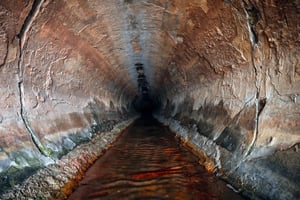 Like other civil infrastructure in the U.S., many of our sewer, storm and water lines are over 50 years old (BAFuture). One of the biggest issues facing underground infrastructure is corrosion. A study from NACE International estimates the annual direct cost of corrosion for the water and wastewater industry is $36 billion. This cost includes replacing extremely corroded lines; lost water from cracks and breaks; application of corrosion inhibitors, internal linings and external linings; external coatings and cathodic protection.
Like other civil infrastructure in the U.S., many of our sewer, storm and water lines are over 50 years old (BAFuture). One of the biggest issues facing underground infrastructure is corrosion. A study from NACE International estimates the annual direct cost of corrosion for the water and wastewater industry is $36 billion. This cost includes replacing extremely corroded lines; lost water from cracks and breaks; application of corrosion inhibitors, internal linings and external linings; external coatings and cathodic protection.
There are many types of corrosion that underground pipelines can experience:
- Erosion: This is the simplest type of corrosion and the most common cause for sewer infrastructure. A corrosive liquid flowing along a line wears away at the material, leaving grooves, gullies and general flow pattern on the material. This type of corrosion can cause a failure the fastest.
- Uniform Attack: A chemical or electrochemical reaction causes an overall thinning of the pipe material. This type of corrosion is easy to measure, as its estimated time of failure can be determined using simple chemical tests.
- Galvanic Corrosion: When two different types of metals meet, they can react and corrode when immersed in a corrosive or conductive liquid. Whichever metal is less corrosion-resistant begins to degrade faster than it otherwise would.
- Pitting: This type of corrosion is where small divots or holes form in the walls. Because of their small size, when located close together they can appear to be a rough sidewall. Pitting can be hard to spot because the holes are often covered by debris and corrosion products.
- Dealloying or Selective Leaching: Under certain circumstances, one element can be removed from an alloy. This is common with brass pipes where zinc is removed, leaving a weak copper pipe (Corrosion Doctors).
While corrosion can affect all pipe materials in one way or another, some materials are more prone to corrosion than others. In a 2012 study on water main breaks, Utah State University researchers found that corrosion was the most common failure cause for ductile iron and steel, with 80% of steel pipes and almost half of ductile iron pipes failing due to corrosion. As ductile iron is one of the more common pipe materials in water and sewer lines, corrosion poses a substantial risk to underground infrastructure.
Health & Safety Costs of Corrosion
Apart from the financial costs of corroded pipes, there are also health and safety costs. Corroded water lines leach materials into the water. Without proper treatment and filtration, these materials can harm people. High levels of copper can cause gastrointestinal problems and eventually liver and kidney damage. High lead levels are especially dangerous for children who can experience physical and mental developmental delays.
With sewer lines, the concerns are different. When a pipe corrodes to the point that its contents escape into groundwater or waterways, that can make people sick and harm the environment. Leaking and weakened pipes also pose a sinkhole risk; as groundwater seeps into the line, it carries the surrounding soil with it, creating a void which eventually collapses. The groundwater infiltration also robs the collection system of capacity, filling it with water that does not require treatment.
Ultimately, corrosion is the biggest problem facing water and wastewater infrastructure. Its effects can harm public health and the environment and necessitate costly repairs. While there are many methods for addressing corrosion, the best is prevention. Regular inspection of lines helps identify corrosion so that steps can be taken to curb it and to repair the damage it has caused. Envirosight's Phased Assessment Strategy for Sewers establishes a protocol for inspections to maximize your inspection productivity while minimizing the cost.

